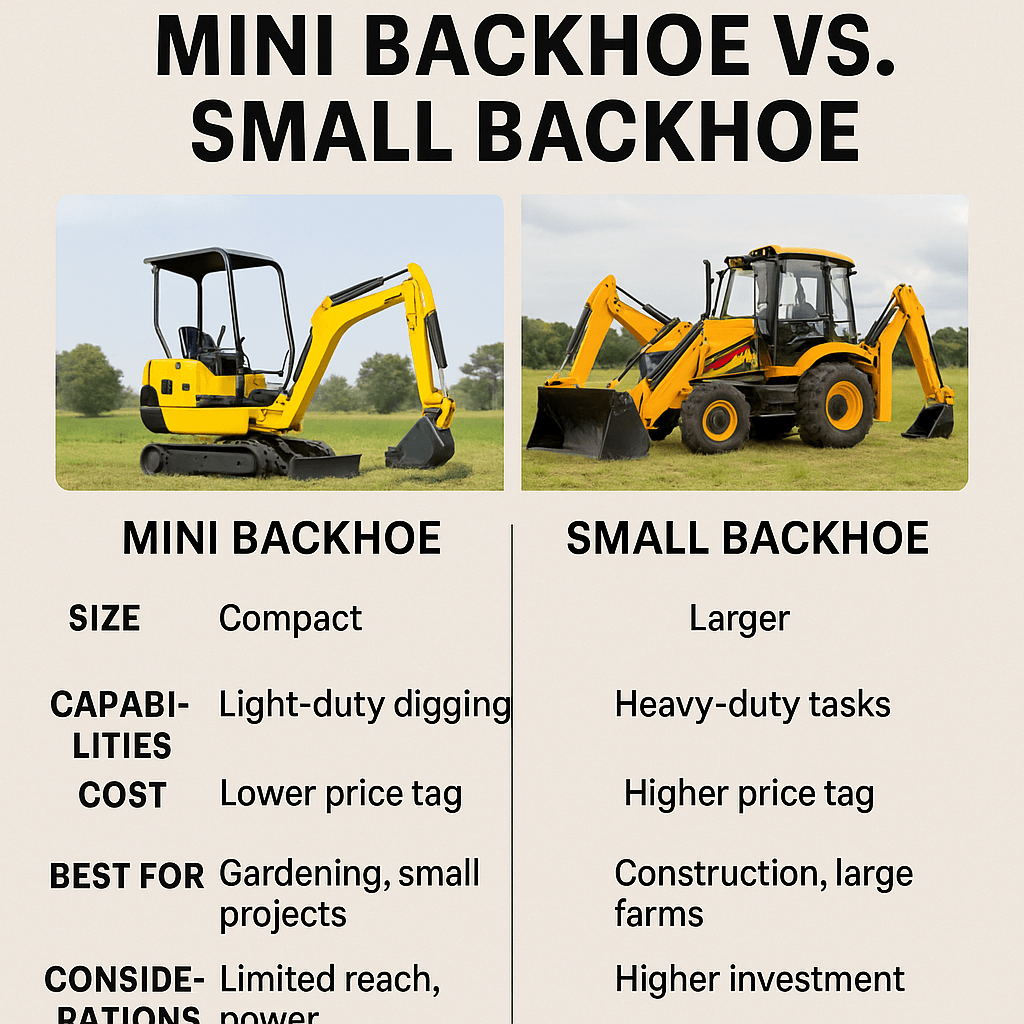Small Backhoe vs Mini Backhoe it’s one of the most common questions farmers, landscapers, and contractors ask when they shop for equipment. Both can trench, dig, and pull heavy loads, but differ in size, price, and power.
This is not a technical decision only; it’s also a matter of budget, work requirements, and long-term investment. In this guide, here we’ll discuss the differences, benefits, drawbacks, cost, and best applications of each type of backhoe so you can make the best choice.
Want to buy today? Browse our Mini Backhoe for Sale listings.
What Is a Mini Backhoe
A mini backhoe, or a compact backhoe loader, is essentially a mini version of the regular backhoe. Its application has gained more popularity among:
Farmers who need an affordable but versatile machine.
Landscapers on residential property with limited space to work in.
Contractors with light jobs and not much budget for a regular-sized backhoe.
Key Features of a Mini Backhoe
Light weight (easy to maneuver in tight yards).
Digging depth: 5–8 feet.
Lighter in weight, easier to transport.
Lower purchase cost (some under $5,000).
Perfect for DIY farm uses and property maintenance.
Some Typical Mini Backhoe Jobs
Digging irrigation ditches.
Placing fence posts or trees.
Moving compost, mulch, or gravel.
Light construction building (drainage, drives).
Check out our blog affordable Mini Backhoe for Sale under $5000 listings today.

What Is a Small Backhoe?
A small backhoe is the next size up from a mini. It is not as large as a full backhoe loader, but larger than a compact unit in digging capacity and reach.
Key Features of a Small Backhoe
Digging depth: 10–14 feet.
More powerful hydraulic lifting system for lifting heavier loads.
Ideal for light-to-medium construction work.
More costly than a mini, but less costly than a standard full-size backhoe.
Common Small Backhoe Jobs
Commercial landscaping.
Roadside or municipal work.
Job site construction trenching.
Doing heavier farm chores.
External reference: John Deere Backhoe Loaders.
Mini Backhoe vs Small Backhoe – Side-by-Side
Feature\tMini Backhoe\tSmall Backhoe
Size\tExtremely compact, ideal for small areas\tA little bigger, still smaller than full backhoes
Price\tReasonably priced; used models less than $5,000\t$10,000–$25,000 (used)
Digging Depth\t5–8 feet\t10–14 feet
Power\tModerate, farm & landscaping\tMore powerful, light construction
Transport\tEasy to tow behind small trailers\tNeeds bigger trailer/truck
Best For\tSmall farms, homeowners\tCommercial farms, contractors
Small Backhoe vs Mini Backhoe: Which Should You Choose?
The right choice depends on your job size, budget, and long-term goals.
Choose a Mini Backhoe If:
You’re on a tight budget ($3,500–$8,000).
You need equipment for light farm or landscaping jobs.
You want a machine that’s easy to store and transport.
You don’t need deep excavation.
Choose a Small Backhoe If:
You handle larger projects (construction, commercial landscaping).
You have a bigger budget ($8,000+).
You require more digging capacity.
You’ll be doing a lot of commercial work with it.
Price Comparison in Detail
Let’s dive deeper into the prices:
Mini Backhoe Prices
Tractor-mounted attachment: $2,500–$5,000.
Used mini backhoe loader: $5,000–$10,000.
New mini backhoe: $10,000–$15,000.
Small Backhoe Prices
Used: $8,000–$15,000.
New: $15,000–$25,000+.
External resource: MachineryTrader – Used Backhoes.
Maintenance and Costs of Ownership
As an owner of a backhoe, it’s not just the purchase cost you must consider maintenance and operational costs.
Mini Backhoe
Less fuel consumption.
Less costly replacement parts.
Easier to operate, fewer breakdowns.
Small Backhoe
Higher fuel use.
More expensive to repair.
Requires more operator training.
Pro tip: If you’re starting out or only need occasional use, a mini backhoe is usually the smarter first investment.
Real-Life Use Cases
Farm Example
A farmer with a 5-acre property might choose a mini backhoe to dig trenches for irrigation, plant trees, and move soil.
Landscaping Example
A homeowner landscaper might choose a mini backhoe because it can be used for small-sized backyards and does not destroy lawns.
Construction Example
A contractor building small foundations for homes might buy a small backhoe because it gives the extra depth of digging and strength needed for heavy digging.
FAQs: Mini Backhoe vs. Small Backhoe
Q1: Which is best suited for farms?
Mini backhoes are best suited for small-to-medium farms, but small backhoes are better suited for large farms.
Q2: Is it possible to buy a small backhoe for under $5,000?
Unlikely but you can buy used mini backhoes or attachments for under $5,000.
Q3: How deep can they dig?
Mini backhoe: 5–8 feet. Small backhoe: 10–14 feet.
Q4: Which holds its resale value better?
Long-standing small backhoe manufacturers like John Deere or Case hold their value better, but mini backhoes are more easily sold quickly because they are so low in cost.
Q5: Which is easier to learn?
Mini backhoes are simpler for beginners, while small backhoes require more skill and practice.
Final Thoughts
Choosing between a small backhoe and a mini backhoe depends on your budget, project size, and long-term goals.
If you’re a homeowner, hobby farmer, or landscaper → A mini backhoe is perfect. Affordable, compact, and versatile.
If you’re a contractor or large-scale farmer → A small backhoe makes more sense. More power, greater depth, but higher cost.
Ready to get started? Visit our Mini Backhoe for Sale page for affordable, compact equipment that gets the job done.